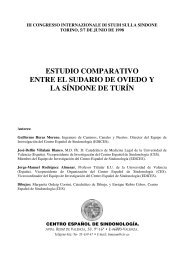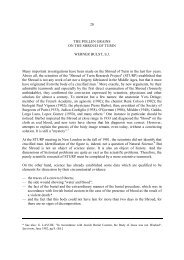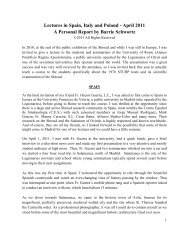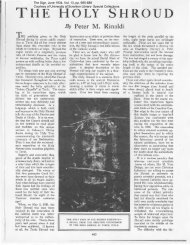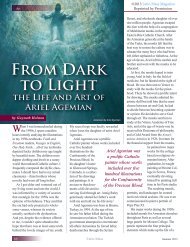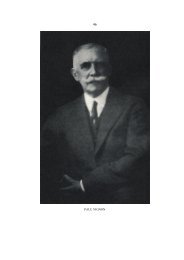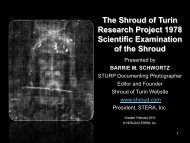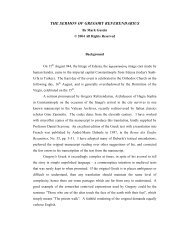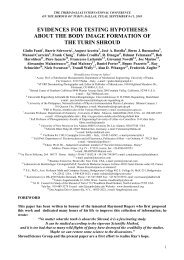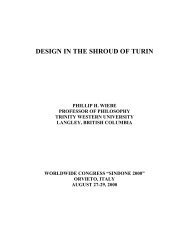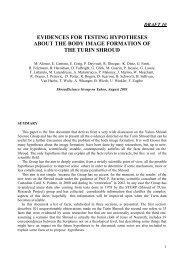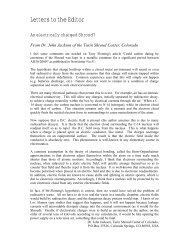Missing Years - Shroud of Turin
Missing Years - Shroud of Turin
Missing Years - Shroud of Turin
You also want an ePaper? Increase the reach of your titles
YUMPU automatically turns print PDFs into web optimized ePapers that Google loves.
The <strong>Shroud</strong>’s “<strong>Missing</strong> <strong>Years</strong>”<br />
by Alessandro Piana<br />
(© Alessandro Piana, 2007)<br />
According to tradition the <strong>Shroud</strong> preserved today in <strong>Turin</strong> is the sheet in which Jesus<br />
was wrapped after the crucifixion. From the 14 th century, when the <strong>Shroud</strong> appeared in<br />
France, in Lirey, there are no historical gaps. The same is not true for the previous<br />
period, even if we can approximately piece together what happened to the Holy <strong>Shroud</strong><br />
based on historical, numismatic and archaeological research. These researches in<br />
association with scientific analysis suggest that <strong>Turin</strong> <strong>Shroud</strong> should be with high<br />
probability older than what is suggested by radiocarbon analysis.<br />
One <strong>of</strong> the more difficult steps in writing the chronology <strong>of</strong> places in which the <strong>Shroud</strong><br />
has been preserved is the historical gap <strong>of</strong> more or less one hundred and fifty years, from<br />
1204 in Constantinople to its re-appearance in Lirey in the 14 th century. Different<br />
hypotheses have been formulated about these “missing years”. 1<br />
One hypothesis extensively accepted is that the Holy <strong>Shroud</strong> that appeared in France,<br />
in Lirey, in the 14th century, is the same one seen in Constantinople in 1204 and taken<br />
during the Crusaders’ plunder. So where was in the years in between<br />
The <strong>Shroud</strong> in Constantinople<br />
In 944 the Byzantine army under John Curcuas besieged Arabian Edessa. 2 The<br />
inhabitants were not able to withstand and losing control <strong>of</strong> the city had to hand over the<br />
most precious treasure preserved in the city, the mysterious image <strong>of</strong> Jesus face “not<br />
made by human hands”. 3<br />
This was taken to Constantinople in triumph on August 15 th <strong>of</strong> the same year. Among<br />
different pro<strong>of</strong>s <strong>of</strong> its arrival in the Byzantine capital there are the 13 th century miniatures<br />
<strong>of</strong> John Skylitzes Cronaca. 4<br />
A crowd accompanied the <strong>Shroud</strong> in a long procession to the Pharos Theotokos<br />
church, near the Bucoleon, where it was placed in the oriental wing. 5<br />
Numerous records <strong>of</strong> ordinary travellers and famous kings in he 11 th and 12 th<br />
centuries 6 mention the presence <strong>of</strong> the <strong>Shroud</strong> in the capital <strong>of</strong> the Eastern Empire, where<br />
it would remain until the Crusade in the 13 th century.<br />
Robert de Clary was a knight and a chronicler <strong>of</strong> the crusade. 7 In August 1203, during<br />
a ceasefire, he visited the city and described in his memories the treasures <strong>of</strong><br />
Constantinople. He wrote:<br />
Among other astonishing things there is a church called Saint Mary <strong>of</strong> Blacherne, where there is the<br />
<strong>Shroud</strong>, in which Our Lord Jesus was wrapped and that every Holy Friday is lifted up vertically, so that<br />
the shape <strong>of</strong> Our Lord could be seen very well. 8
Based on de Clary’s description in those years the <strong>Shroud</strong> was lifted up vertically to<br />
show only the frontal image.<br />
After a short ceasefire, on 12th April the following year there was a second plunder <strong>of</strong><br />
the city by the Crusaders. Many treasures were stolen along with relics.<br />
What happened to the <strong>Shroud</strong> The answer is uncertain. De Clary wrote:<br />
Nobody, nor Greek, neither Latin, knew what happened to the <strong>Shroud</strong> after the city siege. 9<br />
A trace in Athens<br />
We can state that the <strong>Shroud</strong> disappeared from Constantinople in the period between<br />
April 1204 and August 1205.<br />
Three elements confirm the presence <strong>of</strong> the <strong>Shroud</strong> in Athens in the summer <strong>of</strong> 1205.<br />
First <strong>of</strong> all a letter written on 1 st August 1205 by Theodor Angel Comnenus, nephew <strong>of</strong><br />
Isaac II, Byzantine Emperor, during the plunder <strong>of</strong> 1204, to Pope Innocent III. In this<br />
missive Theodor begged the Holy Father to retrieve as soon as possible precious relics<br />
that had been missing for over a year and wrote about the presence <strong>of</strong> the Holy <strong>Shroud</strong> in<br />
Athens. 10<br />
Moreover we have the statement <strong>of</strong> the papal legate Benedict <strong>of</strong> Santa Susanna, who<br />
in the summer <strong>of</strong> 1205 was in Athens to attend an inter-religious meeting.<br />
Then, Nicolas <strong>of</strong> Otranto, the abbot <strong>of</strong> Casola, wrote in 1207 about relics stolen in<br />
1204 and mentioned the fabric used in the burial that he saw subsequently with his own<br />
eyes. Nicolas <strong>of</strong> Otranto was indeed in Athens in 1206 and so it is possible that he saw<br />
the <strong>Shroud</strong>. 11<br />
Considering all this evidence we obtain what Gian Maria Zaccone called: “a<br />
significant global setting”. 12 Sharing out the Eastern Empire<br />
According to agreements existing before the siege new fiefs gained should be<br />
distributed among twenty-four dignitaries, twelve representing Venice and twelve the<br />
army. Fiefs should have a «free and absolute status», should belong completely to new<br />
owners, apart from the right and the service due to the Emperor and Empire, they should<br />
be inherited directly by sons and daughters <strong>of</strong> new owners. Moreover there was a clause<br />
according to which nobody should leave until March 1205, that is they should stay for<br />
one year. 13<br />
After the splitting up <strong>of</strong> the Byzantine empire came the birth <strong>of</strong> the Eastern Latin<br />
Empire, in which they would have Baldwin <strong>of</strong> Fiandra as new emperor, Boniface <strong>of</strong><br />
Monferrato as King <strong>of</strong> Thessalonika, Ge<strong>of</strong>frey <strong>of</strong> Villehardouin (nephew <strong>of</strong> the historian)
as Prince <strong>of</strong> Morea, William de Champlitte as Prince <strong>of</strong> Achaia and Otho de La Roche,<br />
baron <strong>of</strong> Ray-sur-Saône as Lord <strong>of</strong> Athens. 14<br />
Otho de La Roche, Mégaskyr <strong>of</strong> Athens<br />
Among the Burgundy knights taking part in the siege <strong>of</strong> Constantinople was 15 Otho de<br />
la Roche, 16 counsellor for Marquis Boniface <strong>of</strong> Monferrato, knight commander <strong>of</strong> the<br />
Fourth Crusade.<br />
Born around 1170 into a branch <strong>of</strong> the noble family <strong>of</strong> Ray, 17 enthusiastic about setting<br />
free the Holy Land, Otho, giving a good example to many <strong>of</strong> his compatriots «took the<br />
cross» at the Cistercian abbey <strong>of</strong> Cîteaux in 1201. 18<br />
Different sources state that in 1205 Otho married his cousin Isabelle, the last heiress <strong>of</strong><br />
the principal branch <strong>of</strong> the family. 19 Actually it is more probable that the wedding took<br />
place before the siege <strong>of</strong> Constantinople, around 1203. A few years later Otho was<br />
widowed and married Elisabeth de Chappes in Greece. 20<br />
After the election <strong>of</strong> the new Emperor, on May 9th 1204, Otho was with Boniface <strong>of</strong><br />
Monferrato, another three counsellors and an army, riding southward, toward the lands<br />
promised them as fiefs. In autumn 1204, after a stop in Thessalonica, they started their<br />
journey again. 21 After crossing Thessaly and Thermopilae, their platoon arrived in Beozia<br />
and, after rounding Lake Copaïs, they entered Thebes. Considering the route and the<br />
battles faced, we hypothesise that they arrived in Attica, and afterwards in Athens, around<br />
the end <strong>of</strong> 1204 or the beginning <strong>of</strong> 1205. 22<br />
Otho, with some faithful friends, stayed there to domesticate the fief, while the<br />
remaining platoon set <strong>of</strong>f for the Peloponnese. Among the opposition the new lord <strong>of</strong><br />
Athens had to face was the local church, especially Metropolitan Michael Coniatus who,<br />
after a long negotiation, agreed to participate in a religious meeting in Athens in the<br />
summer <strong>of</strong> 1205. A papal legate, Benedict <strong>of</strong> Santa Susanna was present. After the<br />
meeting, considering Otho’s steadiness and perseverance Michael left the site where he<br />
had lived for thirty years and went into exile on the island <strong>of</strong> Kos in the Dodecannese. 23<br />
In the same period the presence <strong>of</strong> the <strong>Shroud</strong> is mentioned in Athens.<br />
Otho’s lands were growing; his sovereignty was absolute in Attica, the region<br />
including Athens after the siege <strong>of</strong> Constantinople. From 1210 on, after other battles three<br />
other regions were added to his lands. A piece <strong>of</strong> Argolide, formed by the cities <strong>of</strong> Argo<br />
and Nauplie, was <strong>of</strong>fered to Otho by Ge<strong>of</strong>froy <strong>of</strong> Villehardouin, as a sign <strong>of</strong> gratitude for<br />
his role in the occupancy <strong>of</strong> Acrocorinth (1209) and the south fortresses. At the end <strong>of</strong><br />
same year, the new Emperor Henry rewarded the lord <strong>of</strong> Athens and the prince <strong>of</strong> Morea,<br />
granting them in the same proportion the Lordship <strong>of</strong> Thebes. Finally Otho also obtained<br />
Beocia and in the north the small independent region <strong>of</strong> Livadia.<br />
Otho organised his lands on the strength <strong>of</strong> the French feudal model. Athens became<br />
the nominal capital and for this reason Otho built his house on the Acropolis while Thebes
ecame the political and military capital.<br />
We still have a picture representing the tower <strong>of</strong> Otho château-fort, destroyed in 1879.<br />
It was square, about twenty-height meters high with a base <strong>of</strong> seven meters on the side<br />
and was erected on the southern side <strong>of</strong> the Propilei.<br />
Otho, as a crusader, did not ignore religion in his lands and mainly monks “colonised”<br />
his new properties. Monks from Bellevaux and La Charité settled in the Byzantine<br />
monasteries <strong>of</strong> Orchomene and Osios-Loukas while, in 1207, orthodox monks were<br />
banned from Daphne monastery, which was assigned to monks from the French abbey <strong>of</strong><br />
Bellevaux. They converted the monastery into a Cistercian abbey, the fifth <strong>of</strong> their<br />
derived abbeys. The monastery remained Cistercian until 1458 when, after the Turkish<br />
invasion, it returned to Orthodox monks.<br />
Despite his efforts to convert his new lands from 1216 and 1223, Otho was<br />
excommunicated because he refused to dispense clergymen from rural work and to hand<br />
over the income <strong>of</strong> some abbeys and churches to the Latin patriarch Gervasius. 24<br />
Otho tried to find a remedy. In a letter dated 1217 he donated part <strong>of</strong> the income from<br />
fishing in the lands <strong>of</strong> La Roche-sur-l’Ognon and Ray-sur-Saône to the Cistercian monks<br />
<strong>of</strong> Bellevaux abbey. Four years later in another letter to Bellevaux he confirmed these<br />
grants. 25<br />
Blood-line <strong>of</strong> Otho de la Roche<br />
Extending his properties, the lord <strong>of</strong> Athens parcelled out his land to his <strong>of</strong>fspring.<br />
Guy, designated successor, settled in Beocia, assisted by Nicolas de Saint-Omer, righthand<br />
man <strong>of</strong> his father. Guillaume was elected governnor <strong>of</strong> Argolide. Otho II received<br />
Argos and Nauplie, but he let his brothers control his lands while he devoted himself to<br />
Ray-sur- Saône. 26<br />
King Louis IX <strong>of</strong> France, in 1258, confirmed what he had obtained from Otho during<br />
the crusade, admitting the Lordship and the noble title for his descendants. The reigning<br />
branch <strong>of</strong> the dukedom was extinguished after more or less one century, in 1311, when<br />
the fifth generation married into to the Brienne family. Gauthier de Brienne, sixth and last<br />
duke <strong>of</strong> Athens, was killed during a battle near lake Copaïs. 27<br />
In order to obtain more information on Otho it was necessary to visit his castle to look<br />
for new clues.<br />
Ray-sur-Saône castle<br />
Ray-sur-Saône castle is today in a small village <strong>of</strong> around two hundred people.<br />
Family documents mention Guy de Ray as the first owner, a valiant knight who was alive<br />
in 1080. It wsa only in 1170 that his nephew <strong>of</strong> the same name first obtained the title <strong>of</strong><br />
Baron <strong>of</strong> Ray. During this period the lands still belonged to the monks <strong>of</strong> Saint-Vincent in
Chalon-sur-Saône, to which was paid out an annual rent <strong>of</strong> a gold coin.<br />
In fact during the medieval period the Counts <strong>of</strong> Burgundy donated some fiefs to<br />
religious orders to defend their lands. Only in 1230 did Otho buy it from Etienne <strong>of</strong><br />
Oiselay, son <strong>of</strong> Count Etienne <strong>of</strong> Burgundy. 28<br />
In the castle, restructured in 18 th century, lives Countess Diane-Régina de Salverte,<br />
direct descendent <strong>of</strong> Otho de la Roche. 29<br />
In the ancient tower <strong>of</strong> the castle are preserved numerous family treasures. Among<br />
these they have objects from the Fourth Crusade, taken there directly by Otho de la<br />
Roche. 30<br />
Our attention is immediately caught by some cross shaped relics. One <strong>of</strong> these<br />
contains a fragment <strong>of</strong> the True Cross, taken from the Bucoleon by the first Duke <strong>of</strong><br />
Athens in 1204 31 and placed in a relic container from Pope Pius IX in 1863. Another two<br />
relic containers, shaped like a Greek cross, preserve a fragment <strong>of</strong> the True Cross with<br />
soil from the Holy Land, while the other contains only soil from where Christ had<br />
stepped. These relic containers could prove the direct origin from Constantinople.<br />
Behind these objects there is a wooden c<strong>of</strong>fer with a label, on which there is written:<br />
13 th century c<strong>of</strong>fer in which was preserved in Ray Castle the <strong>Shroud</strong> <strong>of</strong> Christ brought by Otho de<br />
Ray from Constantinople. 1206.<br />
The front side <strong>of</strong> the c<strong>of</strong>fer is simply chiselled, while in the middle <strong>of</strong> the sides there<br />
are inlaid shields. It is parallelepiped, 45 centimetres long, 25 wide 30 deep. It is on a<br />
base and closed by a lid. A hole in the lid and four on the front side could be the place for<br />
a padlock (Picture 1). According to family tradition it could state that the <strong>Shroud</strong>, after<br />
disappearing from Constantinople, was kept in Ray-sur-Saône castle.<br />
How, when and why the <strong>Shroud</strong> arrived in Ray-sur-Saône<br />
We have to answer three questions. First <strong>of</strong> all how the <strong>Shroud</strong> came to Otho’s hands<br />
and was then transferred to France; then when did it arrive in France and finally if the<br />
folded <strong>Shroud</strong> could be kept in the c<strong>of</strong>fer just described.<br />
As far as the first question is concerned we have two possible answers. We have seen<br />
that Otho followed the Commander in Chief <strong>of</strong> the Crusade, Boniface <strong>of</strong> Monferrato.<br />
During the siege, the Marquis <strong>of</strong> Monferrato came to the Bucoleon and found his treasure.<br />
We have seen that Otho took some relics to France. However, Bucoleon was at a certain<br />
distance from the place were Robert de Clary said he had seen the <strong>Shroud</strong> during the first<br />
siege, i.e. in Saint Mary <strong>of</strong> Blachernae. Emperors in Constantinople lived in the Bucoleon<br />
until the end <strong>of</strong> the 12 th century, then they resided in Blachernae. This is the reason why<br />
the <strong>Shroud</strong> was moved from the Pharos church, near the Bucoleon where it was put in
944, to be transferred to Blachernae, near the new imperial residence.<br />
In my opinion it is not sustainable that in the days <strong>of</strong> savage depredation Otho went to<br />
the church in Blachernae and took the <strong>Shroud</strong>. In fact, there were numerous death<br />
warrants against people who plundered. It is more plausible that during the sharing out <strong>of</strong><br />
the plunder, Otho de la Roche was given the <strong>Shroud</strong>. 32 This could explain how the pious<br />
Otho obtained the most important treasure <strong>of</strong> Christendom without illegal acts. 33<br />
Where could the <strong>Shroud</strong> have been kept during its stay in Athens The most logical<br />
place seems to be in the fortress on the Acropolis, a well guarded place. In the period<br />
immediately after its arrival in Athens it was certainly kept somewhere else as the tower<br />
had not yet been built - probably in a religious building. 34<br />
When was it taken to France We have a lot <strong>of</strong> data regarding this fact. Some studies<br />
state that after having obtained the Lordship <strong>of</strong> Athens, Otho de la Roche never returned<br />
to France. 35 We have seen before that, depending on the agreement established, nobody<br />
could leave new properties before March 1205. Moreover we know that, until the end <strong>of</strong><br />
July the same year, the <strong>Shroud</strong> was still in Greece, as stated in the letter sent to Pope<br />
Innocent III, belonging to the Chartularium Culisanense, and in other witnesses. Based<br />
on family memoirs, Otho returned to France in 1206, to his castle, bringing with him the<br />
<strong>Shroud</strong>. In reality the latest record signalling the presence <strong>of</strong> Otho in Athens is a papal<br />
bull <strong>of</strong> Honorius III dated February 12th 1225. 36 It is interesting to note that just from this<br />
year the Lordship was transferred to Otho’s son Guy. Otho returned to France with his<br />
second wife and contributed to the enrichment <strong>of</strong> Bellevaux abbey. 37<br />
The presence in Europe <strong>of</strong> the <strong>Shroud</strong> after 1204 was confirmed besides the la Roche<br />
familiar tradition by another significant pro<strong>of</strong>. A headstone with a cross on the top outside<br />
<strong>of</strong> the local castle reminds the visitor that the first Lord <strong>of</strong> Athens died in Ray-sur-Saône<br />
in 1224. 38 Actually a document in the archives <strong>of</strong> the diocese <strong>of</strong> Langres states that Otho<br />
died in 1234, while his second wife Elisabeth died two years later. 39 This should prove<br />
that Otho and Elisabeth lived in France to the end <strong>of</strong> their lives. In that period Langres<br />
was part <strong>of</strong> the county <strong>of</strong> Burgundy, in the region <strong>of</strong> Fouvent-Dampierre-Baujeu, west <strong>of</strong><br />
Saône, part <strong>of</strong> the ecclesiastical ward where the Ray family had their properties. In 1236<br />
Clérembault V de Chappes donated lands in Landelaine and some rights over Gyé to the<br />
Trinitarians <strong>of</strong> Gloire-Dieu in Bar-sur-Seine, for: “their souls’ rest, especially for<br />
Elisabeth, his sister, Dame <strong>of</strong> Athens”. 40<br />
Otho was not buried in his own town but in the church in Seveux, a small village near<br />
Ray-sur-Saône, where his headstone is. A close replica <strong>of</strong> this is can be seen in Ray<br />
castle, in the middle <strong>of</strong> the tower floor, near to the case (Picture 2). The plate reproduces<br />
Otho’s arms. He is represented with hands joined in prayer, wearing an ermine gown, a<br />
sign <strong>of</strong> royalty.<br />
The plate has the following epitaph:
MOLA SUB ISTA CI PREMITUR OM(ni)S RAIANI OTHO ROGATE DEUM NE<br />
PREMAT HOSTIS EUM<br />
The translation is:<br />
Under this rock is buried Otho <strong>of</strong> Ray, pray God that the enemy will never surprise him<br />
again.<br />
It has been suggested that this plate does not represent Otho but his nephew Othenin,<br />
who lived almost one century later; because we can not imagine why on his plate there is<br />
not written “Lord <strong>of</strong> Athens”. 41 Instead Bergeret thinks that this is Otho II’s tomb, 42 but<br />
this is not possible because till the end <strong>of</strong> his days Otho II was armed as de la Roche, so it<br />
is strange that there is not a reference to the la Roche family.<br />
Another fact is very important. Seveux is in the region <strong>of</strong> Fouvent-Dampierre-Baujeu<br />
where Otho and his wife spent their last days. So people stating that Otho never returned<br />
to France should explain why the first Lord <strong>of</strong> Athens was not buried, as his successors<br />
were, in Daphne monastery.<br />
Now we come to the last question: could the <strong>Shroud</strong> have been kept in the c<strong>of</strong>fer<br />
present in Ray-sur-Saône castle<br />
Once opened its inner dimensions are more or less 37.5 centimetres long, 16.5 wide<br />
and 25 deep.<br />
The most suitable folding pattern for the c<strong>of</strong>fer dimensions is in 96. 43 This can be<br />
obtained with twelve folds in the length and eight in the width. So we obtain ninety-six<br />
rectangles, 36.33 centimetres long and 13.75 wide. We can not exclude that the <strong>Shroud</strong><br />
was folded in 48 rectangles, 37 centimetres long and 28 wide, and put in the c<strong>of</strong>fer with a<br />
small deformation in respect to the folding obtained.<br />
We have a lot <strong>of</strong> witnesses regarding the existence <strong>of</strong> c<strong>of</strong>fers in which the <strong>Shroud</strong> was<br />
preserved during its movements in different centuries.<br />
At the <strong>Shroud</strong> Museum in <strong>Turin</strong> we can see the c<strong>of</strong>fer used for moving the <strong>Shroud</strong><br />
from Chambéry to <strong>Turin</strong> in 1578. Its shape and dimensions are very similar to that <strong>of</strong> the<br />
one found in Ray-sur-Saône castle.<br />
It is likely that the two c<strong>of</strong>fers could have preserved the <strong>Shroud</strong> in different historical<br />
periods.<br />
A copy <strong>of</strong> the <strong>Shroud</strong> in Ray castle<br />
Further pro<strong>of</strong> supporting the hypothesis <strong>of</strong> a link between Lords <strong>of</strong> Ray-sur-Saône and<br />
the <strong>Shroud</strong> is the fact that in the same show cabinet where the c<strong>of</strong>fer is, there is a drape
50 centimetres long and 30 wide, with floral ornaments. On the fabric is painted the<br />
frontal part <strong>of</strong> a male human being, extremely similar to the man <strong>of</strong> the <strong>Shroud</strong> (Picture<br />
3). In fact, this yellowish body is represented supine with his wrists crossed on the pubis.<br />
On his feet, on his hands and on the side the small red dots represent blood coming from<br />
wounds, caused by nails and the lance. It has a bearded face with protruding cheekbones<br />
and a crown <strong>of</strong> thorns on the forehead.<br />
This image is a lot alike, if not completely similar, to that <strong>of</strong> the <strong>Shroud</strong>. Similar details<br />
are the bruised cheekbones, the marks <strong>of</strong> the crown <strong>of</strong> thorns and the wounds on the left<br />
side. 44 Different is the crossing <strong>of</strong> the hands, left on right, and the feet, that are separated<br />
and not overlapped.<br />
It is surprising and it seems that the painter coupled observation <strong>of</strong> the <strong>Shroud</strong> to some<br />
beliefs <strong>of</strong> the period. More significant examples are the wounds put in the palm <strong>of</strong> the<br />
hands and not in the wrists.<br />
This piece is a lot like the painting <strong>of</strong> the «Besançon <strong>Shroud</strong>». Copies, once realised,<br />
were for important personalities <strong>of</strong> the Church or for noble friends <strong>of</strong> the family.<br />
All these elements suggest that the <strong>Shroud</strong> could have remained in the case in Ray-sur-<br />
Saône when Otho de la Roche returned to France, probably around 1226.<br />
The reasons for concealing the <strong>Shroud</strong> by Otho and his family are that the 12 th<br />
Ecumenical Council, the Fourth Lateran, started on 11 November 1215, 45 banned the<br />
transaction <strong>of</strong> relics, condemning it as sacrilegious. It would have been difficult to explain<br />
the presence in the family <strong>of</strong> such a treasure and so popular veneration was reserved to<br />
the copy shown in Besançon.<br />
So the <strong>Shroud</strong> present in France from 1226 would have been shown in public only one<br />
and a half centuries later, not far away from Ray-sur-Saône.<br />
The <strong>Shroud</strong> and the Vergy family<br />
After one hundred and fifty years the <strong>Shroud</strong> was kept in a collegiate church, built for<br />
this purpose, not far from Ray-sur-Saône castle. Ge<strong>of</strong>froi I de Charny is considered the<br />
first owner <strong>of</strong> the <strong>Shroud</strong> in Lirey in the 14 th century.<br />
Different elements make us think this was not completely true. It is quite strange that<br />
de Charny family did not publicly show this precious treasure until the middle <strong>of</strong> the 14 th<br />
century. It was not by chance that Ge<strong>of</strong>froi I, a well-known knight in France for his<br />
bravery, a friend <strong>of</strong> kings and popes, waited until 1343, a year after his wedding with<br />
Jeanne de Vergy, before building a chapel. 46<br />
We need to point out that if Otho de la Roche had descendants, one <strong>of</strong> them was<br />
Jeanne de Vergy and not Ge<strong>of</strong>froi I. Jeanne probably brought the <strong>Shroud</strong> as a dowry for<br />
the wedding. In fact Ge<strong>of</strong>froi I became Lord <strong>of</strong> Lirey and Savoy only after his marriage<br />
toJeanne.
Moreover, on the brass plaque found in the Seine in the 19 th century, there are coats <strong>of</strong><br />
arms <strong>of</strong> both families, not only de Charny. 47 Besides, in not even one document about<br />
Ge<strong>of</strong>froi I de Charny was the <strong>Shroud</strong> mentioned. In fact, his son, Ge<strong>of</strong>froi II, did not<br />
inherit a <strong>Shroud</strong> when his father died, 48 as in documents related to the foundation <strong>of</strong> the<br />
collegiate church a lot <strong>of</strong> relics are mentioned but not the <strong>Shroud</strong>. 49 In the end, the chance<br />
that the <strong>Shroud</strong> was property <strong>of</strong> Jeanne de Vergy is supported by the fact that in the<br />
period between 1360 and 1389 the <strong>Shroud</strong> was preserved in Monfort-en-Auxois, a de<br />
Vergy property. 50<br />
It is plausible that the king’s request was formulated in the period immediately after<br />
that in which Ge<strong>of</strong>froi I obtained the <strong>Shroud</strong>, that is after his wedding with Jeanne de<br />
Vergy.<br />
To prove the relationship between Jeanne de Vergy and Otho de la Roche we have to<br />
analyse family trees <strong>of</strong> some noble families from Franc-County and Burgundy between<br />
the 12 th and 15 th centuries.<br />
Family Trees<br />
Otho de la Roche married his cousin Isabelle, latest heiress <strong>of</strong> the principal branch <strong>of</strong><br />
the family and, in this way, he obtained the title <strong>of</strong> Baron <strong>of</strong> Ray. From their marriage<br />
three heirs were born: Guy, Bonne and Otho II (Family Tree 1). From the marriage with<br />
Elisabeth de Chappes Guillaume was born.<br />
For our interest Otho II is important. He died in 1254 leaving two daughters,<br />
Guillermette and Isabelle (or Elisabeth), 51 who would marry into the family <strong>of</strong> Oiselay<br />
and de Vergy respectively 52 , and a son, Jean, who would become Baron <strong>of</strong> Ray-sur-<br />
Saône. 53<br />
Let see now the de Vergy family. 54 Jeanne de Vergy was Guillaume’s and Agnès de<br />
Durnayn’s daughter. Her father was the son <strong>of</strong> Jean I and Marguerite de Noyers. Jean I<br />
was son <strong>of</strong> Henry I de Vergy and Isabelle de Ray, daughter <strong>of</strong> Otho II de la Roche and<br />
sister <strong>of</strong> Jean, Lord <strong>of</strong> Ray. 55 These genealogical trees show how Jeanne de Vergy was<br />
related, in the fifth generation, to Otho de la Roche (Family Tree 2).<br />
It was this woman, descendant <strong>of</strong> the man that brought the <strong>Shroud</strong> to France in the 13 th<br />
century, who married Ge<strong>of</strong>froi I de Charny. It is through this wedding that «the most loyal<br />
and valorous <strong>of</strong> all knights» obtained the <strong>Shroud</strong> that, through different generations,<br />
arrived in the hands <strong>of</strong> the de Vergy from the de la Roche family.<br />
But this relationship on its own does not explain when, how or why the <strong>Shroud</strong><br />
changed ownership from Ray-sur-Saône to de Vergy.<br />
While the de la Roche family declined (in 1386 we do not find any trace <strong>of</strong> la Rochesur-l’Ognon<br />
in genealogies 56 ), the Lords <strong>of</strong> Ray-sur-Saône were prospering. Their apogee<br />
was in the 14 th century when two barons, Gauthier (who died in 1357) and Jean II (died in
1394), became “Guardian <strong>of</strong> Burgundy County”, that is they were the people in charge<br />
during the king’s succession or during the king’s absence.<br />
The transfer <strong>of</strong> the <strong>Shroud</strong> from the Lords <strong>of</strong> Ray could be linked to the murder <strong>of</strong> the<br />
sixth and last Duke <strong>of</strong> Athens, Gauthier V de Brienne, that took place on May 13 th 1311,<br />
around lake Copais. This event ended the history <strong>of</strong> the French dukedom <strong>of</strong> Athens that<br />
the Ray family had maintained for a long time. In this period the Lord <strong>of</strong> Ray-sur-Saône<br />
was Aymé; the heiress <strong>of</strong> Ray and Henry I de Vergy were already married, so the link<br />
between the two families was already established. The fact that the <strong>Shroud</strong> arrived in the<br />
hands <strong>of</strong> the de Vergy family could be linked to the fact that in 1191 the de Vergy family<br />
became Senechal <strong>of</strong> Burgundy. 57 The transfer could also have taken place while Jeanne<br />
was going to marry Ge<strong>of</strong>froi I de Charny, a well known man in France.<br />
In the 15 th century another wedding would link the two families (Family Tree 3).<br />
Conclusions and unsolved questions<br />
Based on elements collected up to now we can state that the <strong>Shroud</strong> was in France<br />
from the 13 th century, when Otho, Lord <strong>of</strong> Athens, brought it to his fief, after having<br />
acquired it during the Fourth Crusade. After his death in France in 1234, the <strong>Shroud</strong><br />
remained in Ray-sur-Saône family hands, preserved in a case in the family castle. I think<br />
that this rules out its public exhibition in France for many years, to avoid an<br />
excommunication coming from the fact <strong>of</strong> having stolen memorabilia from the crusade. So<br />
the Holy <strong>Shroud</strong> remained in the castle, apart from some movements following the Lords<br />
<strong>of</strong> Ray, until its handing over to the de Vergy family.<br />
Jeanne de Vergy married Ge<strong>of</strong>froi I de Charny, a valiant knight and friend <strong>of</strong><br />
clergymen and kings, and then decided to show the <strong>Shroud</strong> and asked her husband to<br />
build a church for this purpose, a collegiate church, in Lirey. Her second wedding with a<br />
relative <strong>of</strong> the antipope Clemente VII allowed Jeanne de Vergy to eliminate doubts about<br />
the authenticity <strong>of</strong> the <strong>Shroud</strong>. 58<br />
What I have tried to prove in these pages about the «<strong>Shroud</strong>’s missing years» would<br />
be one more piece in the puzzle <strong>of</strong> the history <strong>of</strong> the <strong>Shroud</strong>.<br />
I do not think we can say that the missing period is definitely solved as we still have a<br />
lot <strong>of</strong> research to do. First <strong>of</strong> all we need to understand if in the period in Ray-sur-Saône<br />
the <strong>Shroud</strong> was shown, even privately, and try to obtain further confirmation <strong>of</strong> what the<br />
genealogical trees suggest.<br />
I think that this research should be performed only in situ.<br />
This work has to be considered as the seeds <strong>of</strong> ongoing research, not the end but just the<br />
beginning (Picture 4).<br />
Bibliographical notes
1. For the main theories see: Dubarle A. M., La première captivite de Ge<strong>of</strong>froy de Charny et<br />
l’acquisition du Linceul, in Collegamento Pro Sindone Internet, June 2004, note 31. This article<br />
was previously published on MNTV, n. 8, December 1992, p. 6-18. Wilson I., The <strong>Shroud</strong> <strong>of</strong><br />
<strong>Turin</strong>. The burial cloth <strong>of</strong> Jesus Christ, Image Book, London 1978. Morgan R., Was the Holy<br />
<strong>Shroud</strong> in England, in <strong>Shroud</strong> News, n. 42, August 1987, p. 3-17. Morgan R., The<br />
Templecombe Panel Painting, n. 45, February 1988, p. 3-8. Savio P., Ricerche storiche sulla<br />
Santa Sindone, <strong>Turin</strong> 1957.<br />
2. For complete information about the Holy <strong>Shroud</strong> before Constantinople see: Dubarle<br />
A.M., Storia antica della Sindone di Torino sino al XIII secolo, Edizioni Giovinezza, Rome<br />
1989.<br />
3. This acheiropoietos relic was also known as the Mandylion and we have numerous links<br />
between the Image <strong>of</strong> Edessa and the Holy <strong>Shroud</strong>. According to the most reliable hypothesis,<br />
the Mandylion was the <strong>Shroud</strong> folded in eight, to show only the face. For a comparison between<br />
the <strong>Shroud</strong> and Mandylion see: Wilson I., op. cit..<br />
4. Giovanni Skylitzés, Cronaca (XIII secolo). Madrid, National Library, cod. gr. Vitr. 26-2,<br />
f. 205 r., f. 131 r. De immagine edessena Costantini Porfirogeniti traslata (Codex Ambrosianus<br />
D. 52s, 69).<br />
5. Barbesino F., Moroni M., Lungo le strade della Sindone, San Paolo, Cinisello Balsamo<br />
1998, p. 21.<br />
6. Piana A., Sindone: gli anni perduti, Sugarco, Milan 2007, pp. 39-41.<br />
7. Robert de Clary, coming from Amiens, left Clary-les-Pernois fief in 1202 to follow Pierre<br />
d’Amiens in the crusade.<br />
8. Roberto di Clari, La conquista di Costantinopoli, a cura di Nada Patrone A. M., Genoa<br />
1972, p. 227 and following.<br />
9. Ibidem<br />
10. Chartularium Culisanense f. CXXVI. Si veda: Rinaldi P., Un documento probante sulla<br />
localizzazione in Atene della Santa Sindone dopo il saccheggio di Costantinopoli, in La<br />
Sindone. Scienza e fede, Atti del convegno di Bologna 1981, Bologna 1983, p. 109-113.<br />
11. Scavone D.C., The <strong>Shroud</strong> in Constantinople: The documentary evidence, pp. 312-337. in<br />
Robert F. Sutton Jr.., Daidalikon, Bolchazy-Carducci, Wauconda (IL) 1989. Baima Bollone P.,<br />
Sindone 101 domande e risposte, San Paolo, Cinisello Balsamo 2000, p. 53.<br />
12. Zaccone G.M., Sulle tracce della Sindone, Elledici, Leumann 1997, p.40.<br />
13. Meschini M., 1204: l’incompiuta. La quarta crociata e le conquiste di Costantinopoli,<br />
Ancora, Milan 2004, pp. 123-124.<br />
14. Monk Aubry de Trois-Fontaines, in his Chronicon, adressed Otho de la Roche as Duke<br />
<strong>of</strong> Athens (Aubry Chronicon is mentioned from Vignon P., Le Saint Suaire de <strong>Turin</strong> devant la<br />
science, l’archéologie, l’histoire, l’iconographie, la logique, Paris 1938, p. 107-108.). Really it<br />
is from Jean de la Roche (1263-1280) that the title <strong>of</strong> Duke is used as an alternative to<br />
Mégaskyr. Under Guillaume (1280-1287), his successor, only the title Duke <strong>of</strong> Athens was used.<br />
15. de Villehardouin G., Histoire de la conquète de Costantinople, a cura di de Wailly N.,<br />
Librairie Hachette, Paris 1872, p. 146-149.<br />
16. Lord <strong>of</strong> La Roche-sur-l’Ognon, village located around Ognon river, not far away from<br />
Besançon.<br />
17. Noble family <strong>of</strong> Ray-sur-Saône, village <strong>of</strong> Franc-County in department <strong>of</strong> Haute-Saône.<br />
18. de Salverte H., Historique du Château de Ray, Ed. Sequania, Besançon 1999, p. 15.
19. Dunod F. I., Histoire des Séquanais, XVIII secolo. Quoted also in family trees.<br />
20. Born from Clérembault IV de Chappes and Elissande de Trainel, coming from the noble<br />
families <strong>of</strong> Bar-sur-Aube region, related to Guarnieri <strong>of</strong> Trainel, bishop <strong>of</strong> Troyes, took part in<br />
the Fourth Crusade as a spiritual leader.<br />
21. Girard J., La Roche et l’épopée comtoise de Grèce, L’Atelier du Grand Tétras, Mont-de-<br />
Laval 1998, p. 71-73.<br />
22. According to Scavone (Scavone D. C., La Sindone di Torino, Otho de la Roche,<br />
Besançon, e il Memorandum d’Arcis: Un’elaborazione e una sintesi, in Collegamento Pro<br />
Sindone, Genuary-February 1993, p. 37) he arrived in Athens bewteen the end <strong>of</strong> October and<br />
the beginning <strong>of</strong> November 1204.<br />
23. Girard J., op. cit., p. 73.<br />
24. Lognon, Les premiers Ducs d’Athens et leur famille, in Journal des Savants, Genuary-<br />
March 1973. There are almost twelve letters adressed to Otho from Pope Innocence III,<br />
between 1208 and 1213 and another eight to Pope Honorius III, from 1217 to 1225.<br />
25. The two documents are preserved in Departmental Archives <strong>of</strong> Haute- Saône: Abbaye de<br />
Bellevaux, H 119.<br />
26. On his father’s death Otho II reached an agreement with his cousin Pons de Cicon and<br />
gave up his rights over La Roche-sur-l’Ognon fief. In the “Nauplie Charter”, dated April 19th<br />
1251, Otho II gave up his fiefs <strong>of</strong> Argos and Nauplie for some money and some rights <strong>of</strong> Guy<br />
over family properties in Burgundy and Champagne, thus centralising power in Ray-sur- Saône.<br />
27. Other dukes <strong>of</strong> Athens were: Guy (1225-1263); Jean (1263-1280); Guillaume (1280-<br />
1287); Guy II (1287-1308); Gauthier V de Brienne (1308-1311).<br />
28. Departmental Archives <strong>of</strong> Doubs, B 485<br />
29. The name <strong>of</strong> de Ray disappeared in 1623 on the death <strong>of</strong> Claude François de Ray, who<br />
did not have male heirs. Women from the family married into the Marmier family and, thereafter,<br />
with de Salverete.<br />
30. Chamard F., Le linceul du Christ, étude critique et historique, Oudin, Parigi 1902.<br />
31. Based on de Salverte (de Salverte H., Petit Guide pour les Visiteurs du Château et du<br />
Parc de Ray, Gray 1980, p. 3) fragments <strong>of</strong> True Cross were found in Blacherne palace.<br />
32. Dunod F. I., Histoire de l’église, ville et diocèse de Besançon, volume I, p. 408.<br />
33. According to Scavone (Scavone D.C., op. cit., p.38) Otho could have obtained the<br />
<strong>Shroud</strong> from the new Emperor Henry following his wedding with Agnese <strong>of</strong> Monferrato,<br />
celebrated in February 1207, as acknowledgement for his services. That is in contrast with<br />
attestations about the <strong>Shroud</strong>’s presence in Athens in the summer <strong>of</strong> 1205.<br />
34. Religious buildings probably are: a church in Athens, Parthenon and Daphni monastery<br />
(Raffard de Brienne D., Le ducs d’Athènes et le Linceul, in Actes du IIIème Symposium<br />
Scientifique International du CIELT, Nice, 12-13 May 1997, p. 171).<br />
35. Scavone D. C., op. cit., p.40. Raffard de Brienne D., op.cit., p. 171.<br />
36. Regesta honor. II papae III, 332-986, 1819, 3924-4503-4514.<br />
37. Hopf, Chronique gréco-romaine, Weidman, Berlin 1873.<br />
38. Also quoted in de Salverte H., Historique du Château de Ray, Ed. Sequania, Besançon<br />
1999, p. 17.<br />
39. Jacques Vignier: Décade historique du diocèse de Langres - Tomo III -f. 6- France<br />
National Library FR 5995.<br />
40. Girard J., op. cit., note 30 p. 102.<br />
41. Mémoires de la Commission Archéologique de la Haute-Saône, 3-4, Per. 257.
42. Bergeret M., Linceul de <strong>Turin</strong>- le trou historique: 1204-1357, in L’identification<br />
scientifique de l’homme du Linceul, Actes du Symposium Scientifique International du CIELT,<br />
Rome 10-12 June 1993, p. 347.<br />
43. Ibidem. And also: Barta C., Hipótesis para el vacío histórico de Constantinopla a Lirey,<br />
in Linteum n. 36, June 2004, p. 32.<br />
44. The side wound that on the <strong>Shroud</strong> we see on the left side on the negative that reveals<br />
royalty is on the right side.<br />
45. Rendina C., I Papi. Storia e segreti, Newton & Compton, Rome 2005, p. 448.<br />
46. National Archives <strong>of</strong> Paris, MS. J.J. 1174, n° 315.<br />
47. Musée National du Moyen-Age Thermes et hôtel de Cluny, Paris.<br />
48. The <strong>Shroud</strong> is not mentioned in the funeral memorial written by the Dean <strong>of</strong> the<br />
collegiate church (Legrand A., Le Linceul de <strong>Turin</strong>, Desclée de Brouwer, 1980).<br />
49. de Gail P., Histoire religieuse du Linceul du Christ, Editions France-Empire, Paris 1973.<br />
50. Bergeret M., op. cit., p. 347. It seems that on the initiative <strong>of</strong> Jeanne de Vergy, in 1360<br />
the <strong>Shroud</strong> was moved to Monfort-en-Auxois castle where it stayed until 1389 (Pays de<br />
Bourgogne, n. 199, March 2003).<br />
51. In the Middle Ages the names <strong>of</strong> Elisabeth and Isabelle were equivalent (Bergeret M., op.<br />
cit., p.348).<br />
52. Girard J., op.cit., p. 225.<br />
53. de Salverte H., Historique du Château de Ray, Ed. Sequania, Besançon 1999, see<br />
following genealogical table.<br />
54. Piana A., op. cit., pp. 90-91.<br />
55. Père Anselme de Sainte-Marie (Pierre de Guibours), Histoire généalogique et<br />
chronologique de la maison royale de France, des pairs, grands <strong>of</strong>ficiers de la couronne et de<br />
la maison du roy et des anciens barons du royaume. (Reprod. de l'éd. de Paris : chez Estienne<br />
Loyson, 1674: Num. BNF de l'éd. de Paris: Bibliothèque nationale de France, 1987).<br />
56. Departmental Archives <strong>of</strong> Doubs, B 435<br />
57. Currer-Briggs N., The <strong>Shroud</strong> and the Grail, St. Martin’s Press, New York 1987.<br />
58. Amedeo IV de Genève married Jeanne de Vergy in 1357, was related to anti-pope<br />
Clemente VII who attended to the Lirey controversy.



